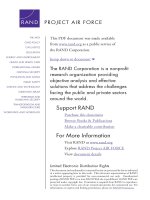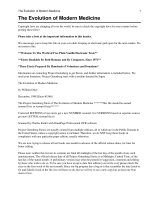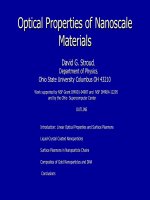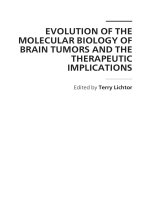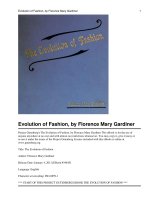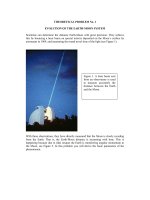Incremental evolution of classifier agents using incremental genetic algorithms
Bạn đang xem bản rút gọn của tài liệu. Xem và tải ngay bản đầy đủ của tài liệu tại đây (2.75 MB, 170 trang )
INCREMENTAL EVOLUTION OF
CLASSIFIER AGENTS USING
INCREMENTAL GENETIC ALGORITHMS
ZHU FANGMING
(B.Eng. & M.Eng. Shanghai Jiaotong University)
A THESIS SUBMITTED
FOR THE DEGREE OF DOCTOR OF PHILOSOPHY
DEPARTMENT OF ELECTRICAL AND COMPUTER ENGINEERING
NATIONAL UNIVERSITY OF SINGAPORE
2003
i
Acknowledgements
I am most grateful to my supervisor, Prof. Guan Sheng-Uei, Steven, for his continuous
guidance during my PhD program.
I am truly indebted to the National University of Singapore for the award of the
research scholarship, which supports me to finish this research.
I would also like to thank all my family members – my wife, son, parents, and
parents-in-law. The warm encouragement from them really supports me to ride out the
difficulties. I also present this thesis to my lovely son, who brought me much
happiness during the whole process of my thesis writing.
Last but not least, I would like to thank all the fellow colleagues in Computer
Communication Network Laboratory, and all the research students under Prof. Guan.
My heartfelt thanks goes out to many friends who keep encouraging and helping me.
Contents
ii
Contents
Summary vi
List of Figures viii
List of Tables x
1 Introduction 1
1.1 Software Agents 1
1.2 Evolutionary Agents 3
1.3 Incremental Learning for Classifier Agents 4
1.4 Background and Related Work 9
1.4.1 Genetic Algorithms for Pattern Classification and Machine Learning 9
1.4.2 Incremental Learning and Multi-Agent Learning 12
1.4.3 Decomposition and Feature Selection 15
1.5 Approaches and Results 18
1.6 Structure of this Thesis 21
2 Incremental Learning of Classifier Agents Using Incremental
Genetic Algorithms 23
2.1 Introduction 23
2.2 Incremental Learning in a Multi-Agent Environment 25
Contents
iii
2.3 GA Approach for Rule-Based Classification 26
2.3.1 Encoding Mechanism 28
2.3.2 Genetic Operators 29
2.3.3 Fitness Function 31
2.3.4 Stopping Criteria 32
2.4 Incremental Genetic Algorithms (IGAs) 32
2.4.1 Initial Population for IGAs 33
2.4.2 Biased Mutation and Crossover 36
2.4.3 Fitness Function and Stopping Criteria for IGAs 37
2.5 Experiment Results and Analysis 37
2.5.1 Feasibility and Performance of Our GA Approach 39
2.5.2 Training Performance of IGAs 40
2.5.3 Generalization Performance of IGAs 45
2.5.4 Analysis and Explanation 51
2.6 Discussions and Refinement 54
2.7 Conclusion 58
3 Incremental Genetic Algorithms for New Class Acquisition 59
3.1 Introduction 59
3.2 IGAs for New Class Acquisition 61
3.3 Experiment Results and Analysis 65
3.3.1 The Wine Data 66
3.3.2 The Iris Data 70
3.3.3 The Glass Data 72
Contents
iv
3.4 Conclusion 74
4 Continuous Incremental Genetic Algorithms 75
4.1 Introduction 75
4.2 Continuous Incremental Genetic Algorithms (CIGAs) 76
4.3 Experiments with CIGA1 and CIGA3 78
4.4 Experiments with CIGA2 and CIGA4 82
4.5 Comparison to other methods 89
4.6 Discussions 90
4.7 Conclusion 91
5 Class Decomposition for GA-based Classifier Agents 93
5.1 Introduction 93
5.2 Class Decomposition in GA-based Classification 94
5.2.1 Class Decomposition 95
5.2.2 Parallel Training 96
5.2.3 Integration 97
5.3 Experiment Results and Analyses 99
5.3.1 Results and Analysis – GA Based Class Decomposition 99
5.3.2 Results and Analysis – IGA Based Class Decomposition 104
5.3.3 Generalization Performance and Comparison to Related Work 107
5.4 Conclusion 110
6 Feature Selection for Modular GA-based Classifier Agents 111
6.1 Introduction 111
6.2 Relative Importance Factor (RIF) Feature Selection 113
Contents
v
6.3 Experiment Results and Analysis 115
6.4 Discussions 121
6.4.1 Reduction in Rule Set Complexity 121
6.4.2 Comparison to the Application of RIF in Neural Networks 123
6.4.3 Other Issues of RIF 123
6.5 Conclusion 124
7 Conclusions and Future Research 126
7.1 Conclusions 126
7.2 Future Research 129
References 131
Appendix 144
Publication List 156
Summary
vi
Summary
The embodiment of evolutionary computation techniques into software agents has
been increasingly addressed in the literature within various application areas. Genetic
algorithm (GA) has been used as a basic evolutionary algorithm for classifier agents,
and a number of learning techniques have been employed by GA-based classifier
agents. However, traditional learning techniques based on GAs have been focused on
non-incremental learning tasks, while classifier agents in dynamic environment should
incrementally evolve their solutions or capability by learning new knowledge
incrementally. Therefore, the development of incremental algorithms is a key
challenge to realize the incremental evolution of classifier agents. This thesis explores
the incremental evolution of classifier agents with a focus on their incremental learning
algorithms.
First, incremental genetic algorithms (IGAs) are proposed for incremental learning
of classifier agents in a multi-agent environment. IGAs keep old solutions and use an
“integration” operation to integrate them with new elements, while biased mutation
and crossover operations are adopted to evolve further a reinforced solution with
revised fitness evaluation. Four types of IGAs with different initialization schemes are
proposed and compared. The simulation on benchmark classification data sets showed
that the proposed IGAs can deal with the arrival of new input attributes/classes and
integrate them with the original input/output space. It is also shown that the learning
process can be speeded up as compared to normal GAs. This thesis explores the
Summary
vii
performance of IGAs in two scenarios. The first scenario explores the condition when
classifier agents incrementally learn new attributes, while the other one tackles the case
when the classifier agents incrementally learn new classes.
Second, using the IGAs as our basic algorithms, continuous incremental genetic
algorithms (CIGAs) are proposed as iterative algorithms for continuous incremental
learning and training of input attributes for classifier agents. Rather than learning input
attributes in batch as with normal GAs, CIGAs learn attributes one after another. The
resulting classification rule sets are also evolved incrementally to accommodate new
attributes. The simulation results showed that CIGAs can be used successfully for
continuous incremental training of classifier agents and can achieve better performance
than normal GAs using batch-mode training.
Finally, in order to improve the performance of classifier agents, a class
decomposition approach is proposed. This approach partitions a classification problem
into several class modules in the output domain. Each module is responsible for
solving a fraction of the original problem. These modules are trained in parallel and
independently, and results obtained from them are integrated to form the final solution
by resolving conflicts. The simulation results showed that class decomposition can
help achieve higher classification rate with training time reduced. This thesis further
employs a new feature selection technique, Relative Importance Factor (RIF), to find
irrelevant features in the input domain. By removing these features, classifier agents
can improve classification accuracy and reduce the dimensionality of classification
problems.
List of Figures
viii
List of Figures
2.1 Incremental learning of classifier agents with GA and IGA 26
2.2 Pseudocode of a typical GA 27
2.3 Crossover and mutation 30
2.4 Pseudocode for evaluating the fitness of one chromosome 31
2.5 Pseudocode of IGAs 33
2.6 Formation of a new rule in a chromosome 33
2.7(a) Illustration for integrating old chromosomes with new elements under IS2
34
2.7(b) Pseudocodes for integrating old chromosomes with new elements under
IS1 - IS4 35
2.8 Biased crossover and mutation rates 37
2.9(a) Classifier agent evolving rule sets with 10 attributes 41
2.9(b) IS2 running to achieve rule sets with 13 attributes, compared to the
retraining GA approach. 41
2.10 Effect of mutation reduction rate
α
on the performance of IGAs (test CR
and training time) with the wine data. 49
2.11 Effect of crossover reduction rate
β
on the performance of IGAs (test CR
and training time) with the wine data. 50
2.12 Analysis model for a simplified classification problem. 51
2.13 Refined IGAs with separate evolution of new elements 57
3.1 Pseudocode of IGAs for new class acquisition 60
3.2 Formation of a new chromosome in IGAs with CE or RI 61
List of Figures
ix
3.3 Pseudocodes for the formation of initial population under CE1 and RI1 63
3.4 Pseudocodes for the formation of initial population under CE2 and RI2 64
3.5 Illustration of experiments on new class acquisition 66
3.6 Simulation shows: (a) GA results in agent 1 with class 1 & 2; (b) GA
results in agent 2 with class 2 & 3; (c) IGA (RI1) results in agent 1 with
class 1, 2, & 3 67
4.1 Illustrations of normal GAs and CIGAs 76
4.2 Algorithms for CIGA1 and CIGA3 77
4.3 Comparison of CIGA1, CIGA3, and normal GA on the glass data 80
4.4 Comparison of CIGA1, CIGA3, and normal GA on the yeast data 81
4.5 Algorithms for CIGA2 and CIGA4 82
4.6 Illustration of CIGA2 and CIGA4 83
4.7 Comparison of CIGA2, CIGA4, and normal GA on the wine data 84
4.8 Comparison of CIGA2, CIGA4, and normal GA on the cancer data 86
4.9 Performance comparison of CIGAs on the glass data 87
4.10 Performance comparison of CIGAs on the yeast data 88
5.1 Illustration of GA with class decomposition 95
5.2 The evolution process in three class modules on the wine data 99
5.3 Illustration of experiments on IGAs with/without class decomposition 104
6.1 Rule set for module 1 with all features – diabetes1 data 122
6.2 Rule set for module 1 with feature 4 removed – diabetes1 data 122
List of Tables
x
List of Tables
2.1 IGAs alternatives on the formation of a new population 34
2.2 Details of benchmark data sets used in this thesis 38
2.3 Comparison of various approaches on the wine data classification 39
2.4 Comparison of the performance of IGA on the wine data with various
attribute partitions 42
2.5 Comparison of the performance of IGA on the glass data with various
attribute partitions 44
2.6 Comparison of the performance of IGA on the diabetes data 44
2.7 Comparison of the performance of IGAs on the wine data 46
2.8 Comparison of the performance of IGAs on the cancer data 47
3.1 IGAs alternatives on the formation of a new population for new class
acquisition 62
3.2 Comparison of the performance of IGAs on the wine data with various
class settings 68
3.3 Comparison of the performance of IGAs on the iris data with various
class settings 71
3.4 Comparison of the performance of IGAs on the glass data with various
class settings 73
4.1 Performance comparison on the glass data - CIGA1, CIGA3, and
normal GA 79
4.2 Performance comparison on the yeast data – CIGA1, CIGA3, and
normal GA 81
List of Tables
xi
4.3 Performance comparison on the wine data - CIGA2, CIGA4, and
normal GA 84
4.4 Performance comparison on the cancer data - CIGA2, CIGA4, and
normal GA 85
4.5 Performance comparison of CIGAs on the glass data 88
4.6 Performance comparison of CIGAs on the yeast data 89
5.1 Performance of GA with class decomposition on the wine data 100
5.2 Performance of GA with class decomposition on the iris data 101
5.3 Performance of GA with class decomposition on the diabetes data 102
5.4 Performance of GA with 3-module class decomposition on the glass data103
5.5 Comparison of different approaches of GA with class decomposition on
the glass data 103
5.6 Comparison of performance of IGAs with/without class decomposition on
the wine data 105
5.7 Comparison of performance of IGAs with/without class decomposition on
the iris data 106
5.8 Comparison of performance of IGA with/without class decomposition on
the glass data 106
5.9 Generalization performance of GA with class decomposition on the wine
data 107
5.10 Generalization performance of GA with class decomposition on the iris
data 108
5.11 Generalization performance of GA with class decomposition on the cancer
data 108
5.12 Comparison of error rates of various classification methods on the iris data
109
6.1 RIF value for each feature in different class modules - wine data 116
6.2 Performance of the classifier with/without feature selection - wine data 117
List of Tables
xii
6.3 RIF value for each feature in different class modules - glass data 118
6.4 Performance of the classifier with the complete set of features - glass data
119
6.5 Performance of the classifier with all IRFs removed - glass data 119
6.6 RIF value for each feature in different class modules - diabetes1 data 119
6.7 Performance of the classifier with different set of features - diabetes1
data 120
6.8 Performance of the non-modular GA classifier - diabetes1 data 121
7.1 Rules of thumb for the selection of IGA and CIGA approaches 128
Chapter 1 Introduction 1
Chapter 1
Introduction
1.1 Software Agents
The term "agent" is used increasingly to describe a broad range of computational
entities, although the academia has not reached a generally accepted definition for
agents. Some agents may be physically embodied, such as robotic systems that
cooperatively manipulate objects in a task environment, whereas others may be
computationally coded, which are referred as software agents. In general, software
agents are software entities that carry out some set of operations on behalf of a user or
another program with some degree of independence or autonomy (Bradshaw, 1997;
Maes, 1994).
Despite some diversity in various applications, some common properties can be
identified to make agents different from conventional programs. Each agent might
possess to a greater or lesser degree attributes like those enumerated in (Etzioni and
Weld, 1995) and (Franklin and Graesser, 1996):
• Reactivity: the ability to selectively sense and act;
• Autonomy: goal-directedness, proactive and self-starting behavior;
• Collaborative behavior: can work in concert with other agents to achieve a
common goal;
Chapter 1 Introduction 2
• “Knowledge-level” communication ability: the ability to communicate with
persons and other agents with language more resembling human-like “speech
acts” than typical symbol-level program-to-program protocols;
• Personality: the capability of manifesting the attributes of a “believable”
character such as emotion;
• Adaptability: being able to learn and improve with experience;
• Mobility: being able to migrate in a self-directed way from one host plat-form to
another.
There are many classification approaches in the literature. Nwana's classification
(Nwana, 1996) classifies the agent types according to the attributes of cooperation,
learning, and autonomy. According to their mobility, agents can also be static or
mobile. In terms of reasoning model, agents can be deliberative or reactive. Hybrid
agents are also common in various applications.
Nowadays, agent-based solutions are explored and applied in many science and
engineering applications, such as pattern recognition, scheduling, embedded systems,
network management, simulation, virtual reality, etc. In the domain of commercial
applications, agent-based e-commerce has emerged and become the focus of the next
generation of e-commerce, where software agents act on behalf of customers to carry
out delegated tasks automatically (Zhu et al., 2000). They have demonstrated
tremendous potential in conducting various tasks in e-commerce, such as comparison
shopping, negotiation, payment, etc. (Guan et al., 2000; Guan and Zhu, 2002a; Guan et
al., 2002)
Pattern classification plays an important role in various applications such as image
processing, information indexing, and information retrieval, and agent-based solutions
Chapter 1 Introduction 3
for pattern classification have attracted more and more research interests (Vuurpijl and
Schomaker, 1998). This thesis explores incremental learning of evolutionary agents in
the application domain of pattern classification. These agents are called as classifier
agents.
1.2 Evolutionary Agents
It has attracted much attention in the literature to embody agents with some
intelligence and adaptability (Smith et al., 2000). Soft computing has been viewed as a
foundation component for this purpose. It differs from conventional (hard) computing
in that, unlike hard computing, it is tolerant of imprecision, uncertainty, partial truth,
and approximation (Zadeh, 1997). The principal constituents of soft computing are
fuzzy logic (FL), neural networks (NN), evolutionary computation (EC), and machine
learning (ML) (Nwana and Azarmi, 1997).
Evolutionary computation (EC) is one of the main techniques of soft computing.
As a naturally inspired computing theory, EC has already found applications in the
development of autonomous agents and multi-agent systems (Smith et al. 1999).
Imbuing agents with the ability to evolve their behavior and reasoning capabilities can
give them the ability to exist within dynamic domains. EC techniques are good in any
situation where agents must deal with many interacting variables that can result in
many possible solutions to a problem. The agent’s job, in some situations, is to find the
optimal mix of values of those variables that produce an optimal solution (Namatame
and Sasaki, 1998; Sheth and Maes, 1993; Haynes and Wainwright, 1995).
EC consists of many subcategories, such as evolutionary programming (Fogel et
al., 1991), genetic algorithms (Holland, 1975; Michalewicz, 1996), evolution strategies
Chapter 1 Introduction 4
(Back et al. 1991; Schwefel and Rudolph, 1995), genetic programming (Koza, 1992),
etc. Fogel (1995) and Back et al. (1997) provided a comprehensive treatment on the
foundation and scope of EC. The most widely used form of evolutionary computation
is genetic algorithms (GAs). Specifically, GAs work by maintaining a gene pool of
possible solutions - chromosomes. Successive evaluations of the performance of
chromosomes regarding some fitness function results in the unfit chromosomes being
eliminated. Then mutation and crossover produce new offspring. After some
generations, GAs ensure that the fittest chromosome is evolved as the final solution.
GAs have been widely used in the literature to learn rules for pattern classification
problems, either through supervised or unsupervised learning, and they have been
proved as effective approaches in globally searching solutions for classification
problems (Corcoran and Sen 1994; Ishibuchi et al., 1999). In this thesis, genetic
algorithms (GAs) are used as the basic evolution tools for classifier agents. On its basis,
incremental genetic algorithms (IGAs) are proposed for incremental learning of
classifier agents.
1.3 Incremental Learning for Classifier Agents
When agents are initially created, they have little knowledge and experience with
relatively low capability. It is advantageous if they have the ability to evolve (Zhu and
Guan, 2001a, 2001b; Guan and Zhu, 2002e). Learning is the basic approach for agents
to advance the evolution process, hence the selection of learning techniques is
important for agent evolution. There are a number of learning techniques being
employed by agents in the literature. They can be categorized according to the
following criteria: aim of learning, role of agents, and trigger of learning (Liu, 2001).
Chapter 1 Introduction 5
As the real-world situation is complicated and keeps changing, agents are actually
exposed to a changing environment. Therefore, they need to evolve their solutions to
adapt to various changes. That is, it should incrementally evolve their solutions or
capability by incrementally learning some new knowledge. Another situation may be
that the tasks or changes are too complicated, so that the agents may need to evolve
incrementally, i.e., step by step. For example, an agent is using certain GA to resolve a
new task t. As all the individual chromosomes may perform poorly and therefore the
GA gets trapped in an unfruitful region in the solution space. If a population is first
evolved on an easier task version t’ and then on task t, it may be possible to evolve a
better solution.
The term of incremental learning has been used rather loosely in the literature.
However, there are some common criteria for an incremental learning algorithm, such
as it should be able to learn additional information from new data; it should preserve
previously acquired knowledge; it should be able to accommodate new classes that
may be introduced with new data (Polikar et al., 2001).
Specifically, incremental learning is also critical for classifier agents. There can be
a number of changes occurring for classifier agents in a dynamic environment. For
instance, new training patterns may become available; new attributes may emerge; and
new classes may be found. In order to tackle these changes, classifier agents need to be
equipped with special learning techniques. However, traditional learning techniques
based on GAs have been focused on non-incremental learning. It is assumed that the
problem to be solved is fixed and the training set is constructed a priori, so the
learning algorithm stops when the training set is fully processed. On the contrary,
incremental learning is an ad hoc learning technique whereby learning occurs with the
Chapter 1 Introduction 6
change of environmental settings, i.e., it is a continuing process rather than a one-shot
experience (Giraud-Carrier, 2000). In order to satisfy these requirements, special
approaches need to be designed for incremental learning of classifier agents under
different circumstances. This motivates the research work of this thesis, where
incremental genetic algorithms are proposed for this purpose. In addition, most
literature work in classification uses neural networks as tools for incremental learning,
while very few employ genetic algorithms. As GAs have been widely used as basic
soft computing techniques, the exploration of incremental learning with genetic
algorithms becomes more important. This thesis aims to establish an explorative
research on incremental learning with proposed IGAs. Through this study, the
application domains of GAs can be expanded, as IGAs can cater to more adaptive
applications in a changing environment.
Agents are both self-interested and social. Communication between agents enables
them to exchange information and to coordinate their activities. Multi-agent systems
(MAS) have been established as an important subdiscipline of artificial intelligence. In
general, MAS are computational systems in which several semi-autonomous agents
interact or work together to perform some set of tasks or satisfy some set of goals
(Lesser, 1995; Ferber, 1999; Wooldridge and Jennings, 1995; Jennings et al., 1995).
Learning in single-agent environment and multi-agent environment can be largely
different. To date, most learning algorithms have been developed from a single-agent
perspective. According to Stone and Veloso (1998), single-agent learning focuses on
how one agent improves its individual skills, irrespective of the domain in which it is
embedded. But in a multi-agent environment, the coordinated multi-agent learning is a
more nature metaphor and may improve the effectiveness. There are two streams of
Chapter 1 Introduction 7
research about combining MAS and learning. One regards multi-agent systems in
which agents learn from the environment where they operate. The second stream
investigates the issues of multi-agent learning with a focus on the interactions among
the learning agents (Lesser, 1995).
In this thesis, incremental learning is considered in both single-agent and multi-
agent environment. However, incremental learning in this thesis has some difference
from the above-mentioned multi-agent learning. In conventional approaches, multiple
agents coexist in a competitive and collaborative environment. In order to achieve
optimal solutions for multiple agents, these approaches concern more about
coordination and collaboration among agents. Thus, their research is focused more on
the game theory or constraint-based optimization. In this thesis, we make use of the
communication and information exchange among agents and explore how they can
facilitate incremental learning and boost performance. That is, we explore how agents
can benefit from the knowledge provided by other agents, and how agents can adapt
their learning algorithms to incorporate new knowledge acquired.
In addition to incremental learning, achieving higher performance for classifier
agents is always an ultimate pursuit. In general, classification accuracy and training
time are two main metrics for evaluating classifier performance. There are many
techniques proposed for this purpose, among which decomposition methods and
feature selection have attracted more interests.
The purpose of decomposition methodology is to break down a complex problem
into several manageable subproblems. According to Michie (1995), finding a good
decomposition is a major tactic both for ensuring the transparent solutions and for
avoiding the combinatorial explosion. It is generally believed that problem
Chapter 1 Introduction 8
decomposition can benefit from: conceptual simplification of the problem, making the
problem more feasible by reducing its dimensionality, achieving clearer results (more
understandable), reducing run time by solving smaller problems and by using parallel
or distributed computation and allowing different solution techniques for individual
sub problems. The approach proposed in the thesis is based on the decomposition on
the output classes of classification problems. It is shown that the proposed class
decomposition approach can improve the classification accuracy with training time
reduced. Very little research work has been done for class decomposition with genetic
algorithms. In this thesis, the proposed class decomposition approach is applied to not
only normal GAs, but also IGAs for incremental learning. This actually increases the
adaptability of the decomposition approach, as it can be used in both static and
adaptive applications.
A number of features are usually associated with each classification problem.
However, not all of the features are equally important for a specific task. Some of them
may be redundant or even irrelevant. But they are often unknown a priori. Better
performance may be achieved by discarding some features (Verikas and Bacauskiene,
2002). In many applications, the size of a data set is so large that learning might not
work as well before removing these unwanted features. Reducing the number of
irrelevant/redundant features drastically reduces the running time of a learning
algorithm and yields a more general solution. This helps in getting a better insight into
the underlying concept of a real-world classification problem (Koller and Sahami,
1996; Dash and Liu, 1997). In order to find these irrelevant/redundant features, many
feature selection techniques have been proposed. However, these approaches are based
on neural networks, and most of them are computation-intensive such as knock- out
Chapter 1 Introduction 9
techniques. This motivates us to use an approach to determine irrelevant features with
small computation cost, and apply it to genetic algorithms. This thesis employs a
feature selection technique - relative importance factor (RIF), which was originally
proposed in (Guan and Li, 2002b). RIF has proved its effectiveness with NN-based
classifiers. This thesis explores further the application of RIF in modular GA-based
classifier agents where RIF is used together with the above-mentioned class
decomposition approach. It is shown that RIF is effective with modular-GA based
approach, and its performance is comparable to that of NN-based solutions.
1.4 Background and Related Work
1.4.1 Genetic Algorithms for Pattern Classification and Machine Learning
Pattern recognition/classification problems have been widely used as traditional
formulation of machine learning problems and researched with different approaches
including statistical methods (Fukunaga, 1990; Weiss and Kulikowski, 1991), neural
networks (Yamauchi et al., 1999; Guan and Li, 2001; Su et al., 2001), fuzzy sets
(Setnes and Roubos, 2000), cellular automata (Kang, 2000) and evolutionary
algorithms (Ishibuchi et al., 1997; Merelo et al., 2001; Adeli and Hung, 1995). Among
evolutionary algorithms, GA-based solutions have become one of the popular
techniques for classification. De Jong and Spears (1991) considered the application of
GAs to a symbolic learning task supervised concept learning from a set of examples.
Corcoran and Sen (1994) used GAs to evolve a set of classification rules with real-
valued attributes. Bala et al. (1995)
introduced a hybrid learning methodology that
integrates GAs and decision tree learning in order to evolve optimal subsets of
discriminatory features for robust pattern classification. GAs are used to search the
Chapter 1 Introduction 10
space of all possible subsets of a large set of candidate discrimination features.
Ishibuchi et al. (1999) examined the performance of a fuzzy genetic-based machine
learning method for pattern classification problems with continuous attributes.
Compared to the other methods, GA-based approaches have many advantages. For
example, neural networks have no explanatory power by default to describe why
results are as they are. This means that the knowledge (models) extracted by neural
networks is still hidden and distributed over the network. GAs have comparatively
more explanatory power, as it explicitly shows the evolutionary process of solutions
and the solution format is completely decodable.
GAs are widely used in rule-based machine learning (Goldberg, 1989;
Grefenstette, 1993). Fidelis et al. (2000) presented a classification algorithm based on
GA that discovers comprehensible rules. Merelo et al. (2001) presented a general
procedure for optimizing classifiers based on a two-level GA operating on variable
size chromosomes. There are two general approaches for GA-based rule optimization
and learning (Cordon et al., 2001). The Michigan approach uses GAs to evolve
individual rules, a collection of which comprises the solution for the classification
system (Holland, 1986). Another approach is called the Pitt approach, where rule sets
in a population compete against each other with respect to performance on the domain
task (DeJong, 1988; Smith, 1980). Although little is known currently concerning the
relative merits of these two approaches, the selection of encoding mechanism will not
affect the final solution and performance. In this thesis, the Pitt approach is chosen, as
it is more straightforward. Because each chromosome in the Pitt approach represents a
candidate solution for a target problem, it facilitates implementation of encoding/
decoding mechanisms and genetic operators such as mutation and crossover.
Chapter 1 Introduction 11
Moreover, fitness evaluation is simpler than that in the Michigan approach, as fitness
value is assigned to a single chromosome, not shared by a group of chromosomes.
One innovative form of the traditional GA is variable-length GA (VGA), where the
length of chromosome is not fixed during evolution. VGA is suitable for specific
problems where the representation of candidates is difficult to be determined in
advance. Srikanth et al. (1995) proposed VGA-based methods for pattern clustering
and classification. Bandyopadhyay et al. (2001) combined the concept of chromosome
differentiation with VGA, and designed a classifier that is able to automatically evolve
the appropriate number of hyperplanes to classify different land-cover regions from
satellite images. Incremental genetic algorithm in this thesis is also a type of VGA. For
instance, when new attributes or classes are acquired, chromosomes will be expanded
in terms of structure and length as a result of the integration of the new attributes or
classes. However, the length of chromosome in our approach is still fixed when the
number of attributes remains unchanged, and varied when the new attributes or classes
need to be integrated.
There is a stream of research called parallel genetic algorithms (PGAs) (Cantu-Paz,
2000b; Melab and Talbi, 2001), which are parallel implementation of GAs. PGAs can
provide considerable gains in terms of performance and scalability and they can be
implemented on networks of heterogeneous computers or on parallel mainframes.
Cantu-Paz (2000a) proposed a Markov Chain model to predict the effect of parameters,
such as number of population, size, topology, migration rate, on the performance of
PGAs. Melab and Talbi (2001) explored the application of PGAs in rule mining for
large databases. There are two main models for PGA - Island model and
Neighbourhood model (Cantu-Paz 2000a, 2000b). The first has a number of
Chapter 1 Introduction 12
subpopulations, each containing a number of individuals. Each subpopulation runs like
a canonical GA with some communication (exchange of individuals) between
subpopulations. The second model has each individual located on some topography
with the restriction that it is only allowed to communicate with its immediate
neighbours. The GA with class decomposition approach proposed in this thesis is
similar to the method of PGAs, when it is implemented in a parallel model. The
distinct feature of our class decomposition is that sub-populations in our approach are
all independent, so that there is no migration among them. As a result, training time
can be reduced. Moreover, no interaction required among populations for modules
allows full-fledged parallel implementation. Our design of class decomposition also
ensures that the final solutions are not trapped into local optima. The inner mechanism
is that each module needs to not only classify the data with the target classes correctly,
but also ensure that data for other classes will not be misclassified into these target
classes. The use of intelligent decision rules in the integration step will resolve further
the conflicts among sub-solutions.
1.4.2 Incremental Learning and Multi-Agent Learning
Many researchers have addressed incremental learning algorithms and methods in
various application domains. Giraud-Carrier and Martinez (1994) created a self-
organizing incremental learning model that attempts to combine inductive learning
with prior knowledge and default reasoning. New rules may be created and existing
rules modified, thus allowing the system to evolve over time. The model remains self-
adaptive, while not having to unnecessarily suffer from poor learning environments.
Tsumoto and Tanaka (1997) introduced an incremental learning approach to
